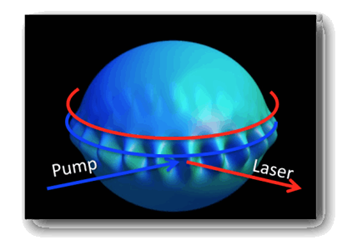Scientists Create First "Water-Wave" Laser
By Jof Enriquez,
Follow me on Twitter @jofenriq

For the first time, scientists have generated lasers from the interaction of light and water waves. This "water-wave" laser can find future application in optofluidic devices and "lab-on-a-chip” devices for studying cell biology and delivering drugs at the nanoscale.
Unlike typical lasers — produced when electrons in atoms are excited by an external source — "water-wave" lasers were previously thought to be more unlikely, because the significant frequency difference between water waves on the surface of a liquid (approximately 1,000 oscillations per second) and light waves (1014 oscillations per second) would reduce the energy needed to generate laser emissions, according to the research team led by Professor Tal Carmon, head of the Optomechanics Center at the Mechanical Engineering Faculty at Technion – Israel Institute of Technology.
Carmon, along with Technion students Shmuel Kaminski, Leopoldo Martin, and Shai Maayani, demonstrated that water wave oscillations within a specially-constructed liquid device also can generate laser radiation.
Their device utilizes an optical fiber to deliver light into an octane microdroplet, where the light and water waves intersect each other approximately one million times, enough to generate the energy needed to emit a "water-wave" laser, according to a news release. The wave interactions are akin to a recordable echo effect, enhanced by the researchers by using highly transparent, runny liquids.
"We fabricate resonators that co-host capillary and optical modes, control them to operate at their non-resolved sideband and observe stimulated capillary scattering and the coherent excitation of capillary resonances at kilohertz rates (which can be heard in audio files recorded by us). By exchanging energy between electromagnetic and capillary waves, we bridge the interfacial tension phenomena at the liquid phase boundary to optics. This approach may impact optofluidics by allowing optical control, interrogation and cooling of water waves," the researchers write in Nature Photonics.
Greater control of the "water-wave" laser is attributed to using a water droplet, which is a million times softer than the materials used in current laser technology, according to the release. The minute pressure applied by light causes droplet deformation that is a million times greater than in a typical optomechanical device, which may lead to greater control of the laser’s emissions and capabilities.
For now, the Technion scientists say their device will serve as a "playground" in studying light and water interactions, two fields that were previously considered unrelated. Future applications include lab-on-a-chip devices to study cellular dynamics, diagnosing diseases, and delivering targeted drug therapies.
